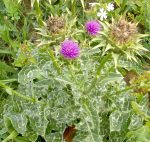 Known by many names including holy thistle, milk thistle and our Lady’s thistle, this annual or biennial is a member of the aster family, Asteraceae, tht also includes daisy, sunflower, and lettuce. It is native to the Mediterranean area where it grows in shrubland, woodland, mountains, and deserts. Plants grow 12-79″ tall and have a deep taproot and fleshy grooved stems which may be hollow and/or covered with soft hairs. The shiny green leaves form a basal rosette and are oblong to lanceolate, 6-24″ long, and pinnately lobed with conspicuous white veins and spiny margins. The red-purple flowerheads are 1.5-5″ across and appear from late spring to summer. Each flowerhead is surrounded by hairless, triangular bracts that have spine-edged appendages and a stout yellow spine on its tip. The fruit is a black achene with a large white pappus. Although a possible choice for a Marian garden because its association with the tears of the Virgin Mary, the plant is generally considered an invasive weed rather than an ornamental. Plants have been grown since ancient times as a medicinal herb and used to treat several problems including liver diseases. The genus name, Silybum, is from the Greek word silybon that referred to some thistle-like plant. The specific epithet, marianum, honors the Virgin Mary and the legend that the leaf coloration was caused by the Virgin’s Mary’s milk as it ran down the leaves.
Known by many names including holy thistle, milk thistle and our Lady’s thistle, this annual or biennial is a member of the aster family, Asteraceae, tht also includes daisy, sunflower, and lettuce. It is native to the Mediterranean area where it grows in shrubland, woodland, mountains, and deserts. Plants grow 12-79″ tall and have a deep taproot and fleshy grooved stems which may be hollow and/or covered with soft hairs. The shiny green leaves form a basal rosette and are oblong to lanceolate, 6-24″ long, and pinnately lobed with conspicuous white veins and spiny margins. The red-purple flowerheads are 1.5-5″ across and appear from late spring to summer. Each flowerhead is surrounded by hairless, triangular bracts that have spine-edged appendages and a stout yellow spine on its tip. The fruit is a black achene with a large white pappus. Although a possible choice for a Marian garden because its association with the tears of the Virgin Mary, the plant is generally considered an invasive weed rather than an ornamental. Plants have been grown since ancient times as a medicinal herb and used to treat several problems including liver diseases. The genus name, Silybum, is from the Greek word silybon that referred to some thistle-like plant. The specific epithet, marianum, honors the Virgin Mary and the legend that the leaf coloration was caused by the Virgin’s Mary’s milk as it ran down the leaves.
Type: Annual or biennial
Bloom: Red-purple flowerheads surrounded by spiny bract in summer
Size: 12-79″ H x up to 62″ W
Light: Full sun
Soil: Fertile, dry, well-drained
Hardiness: Zones 5-9
Care: Low maintenance
Pests and Diseases: None of significance
Propagation: Seed
Photo Credit: Wikipedia